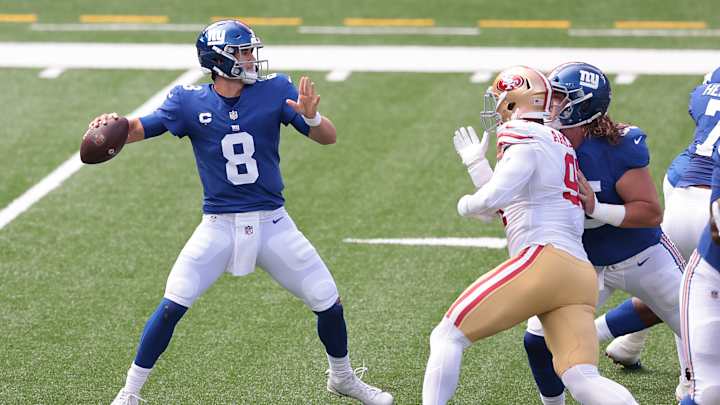Giants Still Trying to Figure Out Things on Offense

To say that Giants offensive coordinator Jason Garrett has had a rough time trying to figure out what works and what doesn’t with the Giants offense would be putting it mildly.
Through four weeks of the NFL season, the Giants offense, which many people anticipated would take on the concepts that the Cowboys ran in Dallas despite there being a difference in the talent level at different positions, hasn't run as many of the concepts that worked so well in Dallas.
Currently, the Giants are last in scoring, averaging just 11.3 points per game, a significant drop from the 21.3 points per game they averaged last year in quarterback Daniel Jones’s rookie season.
Their rushing offense, despite perking up a bit last week against the Los Angeles Rams, is ranked 30th, averaging 76.5 yards per game, just slightly better than cellar-dweller Houston’s 73.5 yards per game.
And the Giants passing offense is also hovering near the bottom of the league, thanks to its 201.5 yards per game, which ranks 29th in the league.
Some will likely point to the Giants missing running back Saquon Barkley behind the sluggish start, but even with Barkley in the lineup for five quarters, that didn’t seem to make much of a difference.
Others might point to the slow start by tight end Evan Engram, who hasn’t flourished like everyone thought would be the case.
Still, others might point to the absence of Sterling Shepard, the Giants one receiver who could consistently find soft spots in zone coverage who is currently on injured reserve.
But Garrett, who like Joe Judge has admitted to still being in a "Getting to know you" phase with is players, admitted that he's trying to figure things out.
The biggest thing we’re all trying to do is simply execute better in both the run game and the pass game. You certainly want to do the things that you’re good at, and we’re trying to discover what those things are both in the run game and the pass game.
On the surface, that doesn’t sound incredibly encouraging, and certainly not when one weighs Garrett’s words with head coach Joe Judge’s vision for the offense.
“I think balanced is what you want to be,” Judge said. “Balance isn’t about running or throwing it 50/50. To me, balance is being able to run it when you have to run it and throw it when you have to throw it. You want to be able to play the game on your terms.”
Thus far, the Giants haven’t been able to do that, as Garrett continues his search for ways to achieve that balance.
The injuries are certainly one stumbling block, but every team has them, so injuries alone shouldn’t be an excuse.
The play of the offensive line? That has certainly come up given the unit’s inconsistency, though Jones also needs to take his share of the blame for those times when he holds the ball too long.
The receivers? You could make the argument that the Giants receivers aren’t getting open or separating as often as they need to, which has forced Garrett to scale back what he’s been trying to do.
You could also argue that Jones’s receivers have dropped 10 of his passes, which ties him for second-most in the league.
But Russell Wilson of the Seahawks, Dak Prescott of the Cowboys, Josh Allen of the Bills, and Matthew Stafford of the Lions have the same number of drops, and their respective offenses aren't nearly as bad stat-wise as the Giants'.
You can also look at how the offense has been run in the first four weeks, a look that has been almost vanilla in nature and, at times, has lacked creativity.
For example, the Giants haven't done much of pre-snap motion, which is thought to be something that might help Jones in getting a jump on untangling defensive disguises.
The Giants also haven’t taken very many chances deep down the field—per PFF, they’ve attempted just eight passes of 20 or more yards, of which Jones has four completions for 117 yards and one touchdown for a 135.4 NFL rating.
"You want to make sure you find ways to keep a defense off-balance, whether it’s using tempo, which we’ve used a lot of this year, whether it’s using formations and movements, or just a combination of run and pass and different ways to do that," Garrett said.
"We’re all trying as a coaching staff to do a great job of putting our players in a good position, and then we have to execute when the ball turns over.
